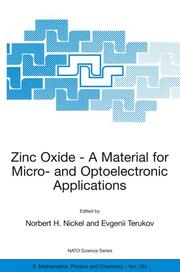Zinc Oxide - A Material for Micro- and Optoelectronic Applications von Norbert H Nickel/Evgenii Terukov
Zinc Oxide - A Material for Micro- and Optoelectronic Applications
NATO Science Series II: Mathematics, Physics and Chemistry, Volume 194, NATO Science Series II: Mathematics, Physics and Chemistry 194
ISBN/EAN: 9781402034732
Sprache: Englisch
Umfang: xvi, 240 S.
Einband: gebundenes Buch
Erschienen am
18.08.2005
Auf Wunschliste
Recently, a significant effort has been devoted to the investigation of ZnO as a suitable semiconductor for UV light-emitting diodes, lasers, and detectors and hetero-substrates for GaN. Research is driven not only by the technological requirements of state-of-the-art applications but also by the lack of a fundamental understanding of growth processes, the role of intrinsic defects and dopants, and the properties of hydrogen. The NATO Advanced Research Workshop on "Zinc oxide as a material for micro- and optoelectronic applications", held from June 23 to June 25 2004 in St. Petersburg, Russia, was organized accordingly and started with the growth of ZnO. A variety of growth methods for bulk and layer growth were discussed. These techniques comprised growth methods such as closed space vapor transport (CSVT), metal-organic chemical vapor deposition, reactive ion sputtering, and pulsed laser deposition. From a structural point of view using these growth techniques ZnO can be fabricated ranging from single crystalline bulk material to polycrystalline ZnO and nanowhiskers. A major aspect of the ZnO growth is doping. n-type doping is relatively easy to accomplish with elements such al Al or Ga. At room temperature single crystal ZnO exhibits a resistivity of about 0. 3 -cm, an electron mobility of 2 17 -3 225 cm /Vs, and a carrier concentration of 10 cm. In n-type ZnO two shallow donors are observable with activation energies of 30 - 40 meV and 60 - 70 meV.
InhaltsangabeContributing Authors. Preface. Part I: ZnO bulk and layer growth: The Scope of Zinc Oxide Bulk Growth; R. Triboulet et al. Growth Mechanism of ZnO Layers; A.Kh. Abduev et al. Kinetics of High-Temperature Defect Formation in ZnO in the Stream of Oxygen Radicals; M.B. Kotlyarevsky et al. Part II: Electrical, Optical, and Structural Properties: Electrical Properties of ZnO; David C. Look et al. Electrical Properties of ZnO Thin Films and Single Crystals; M. Grundmann et al. Structure, Morphology, and Photoluminescence of ZnO Films; V.A. Karpina. Optics and Spectroscopy of Point Defects in ZnO; Vladimir Nikitenko. Whispering Gallery Modes in Hexagonal Zinc Oxide Micro- and Nanocrystals; T. Nobis et al. Properties of Dislocations in Epitaxial ZnO Layers Analyzed by Transmission Electron Microscopy; E. Muller et al. Part III: Role of Hydrogen: Muon Spin Rotation Measurements on Zinc Oxide; E.A. Davis. Hydrogen Donors in Zinc Oxide; M.D. McCluskey and S.J. Jokela. HydrogenRelated Defects in Zno Studied by JR Absorption Spectroscopy; E.V. Lavrov et al. Influence of the Hydrogen Concentration on H Bonding in Zinc Oxide; N.H. Nickel. Part IV: Fundamental properties: Valence Band Ordering and MagnetoOptical Properties of Free and Bound Excitons in ZnO; A.V. Rodina et al. Fundamental Optical Spectra and Electronic Structure of Zno Crystals; V. Val et al. PhotoInduced Localized Lattice Vibrations in ZnO Doped with 3d Transition Metal Impurities; Alexey Kislov. Part V: Device applications: ZnO Window Layers for Solar Cells; W. Fuhs. ZnO/AlGaN Ultraviolet Light Emitting Diodes; E.V. Kaunina et al. ZnO Transparent ThinFilm Transistor Device Physics; J.F. Wager. Zinc Oxide Thin Film Transistors; E. Fortunato et al. Index
Contributing Authors. Preface. Part I: ZnO bulk and layer growth: The Scope of Zinc Oxide Bulk Growth; R. Triboulet et al. Growth Mechanism of ZnO Layers; A.Kh. Abduev et al. Kinetics of High-Temperature Defect Formation in ZnO in the Stream of Oxygen Radicals; M.B. Kotlyarevsky et al. Part II: Electrical, Optical, and Structural Properties: Electrical Properties of ZnO; David C. Look et al. Electrical Properties of ZnO Thin Films and Single Crystals; M. Grundmann et al. Structure, Morphology, and Photoluminescence of ZnO Films; V.A. Karpina. Optics and Spectroscopy of Point Defects in ZnO; Vladimir Nikitenko. Whispering Gallery Modes in Hexagonal Zinc Oxide Micro- and Nanocrystals; T. Nobis et al. Properties of Dislocations in Epitaxial ZnO Layers Analyzed by Transmission Electron Microscopy; E. Muller et al. Part III: Role of Hydrogen: Muon Spin Rotation Measurements on Zinc Oxide; E.A. Davis. Hydrogen Donors in Zinc Oxide; M.D. McCluskey and S.J. Jokela. Hydrogen-Related Defects in Zno Studied by JR Absorption Spectroscopy; E.V. Lavrov et al. Influence of the Hydrogen Concentration on H Bonding in Zinc Oxide; N.H. Nickel. Part IV: Fundamental properties: Valence Band Ordering and Magneto-Optical Properties of Free and Bound Excitons in ZnO; A.V. Rodina et al. Fundamental Optical Spectra and Electronic Structure of Zno Crystals; V. Val et al. Photo-Induced Localized Lattice Vibrations in ZnO Doped with 3d Transition Metal Impurities; Alexey Kislov. Part V: Device applications: ZnO Window Layers for Solar Cells; W. Fuhs. ZnO/AlGaN Ultraviolet Light Emitting Diodes; E.V. Kaunina et al. ZnO Transparent Thin-Film Transistor Device Physics; J.F. Wager. Zinc Oxide Thin Film Transistors; E. Fortunato et al. Index







